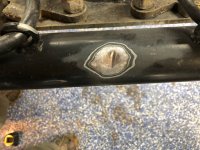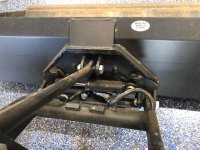johara1
Platinum Member
Ernie, maybe thats how PT. adjusted the rod to get clearance ?? jim
Thanks for the laugh!Ernie, maybe thats how PT. adjusted the rod to get clearance ?? jim
Thanks for the laugh!
That's solid steel. There's no adjusting it.
All the best, Peter
Thanks for the laugh!
That's solid steel. There's no adjusting it.
All the best, Peter


I printed your question then went and looked......crazy how verbal descriptions can get misunderstood. Yes, the top fingers are indeed longer (9") than the bottom fingers (8 1/2"). Good suggestion though as I could see where that could cause a problem.
Well, I'm not a welder but managed to fill the dent. No idea if this really returns the tube to it's original full strength integrity or not but Terry said that's what they'd do at the factory.
View attachment 587994View attachment 587995
The cause still isn't addressed. There will definitely still be contact when the QA plate is in full down and retracted (top of QA plate toward the driver) position. Actually in that position it's fine, it's the 1/2" of free-play in the linkage that does the damage.
I'd rather not restrict the cylinder and reduce range of motion....even if I knew what, exactly, a "restrictor" is.
I could weld stops to the tube as suggested but then I'd just have the collar on either side of the rod knuckle banging into the stops on the tube and perhaps causing two new issues? Plus, is it ok to weld flat stock to a cylinder for this type of repair?
I could grind down the knuckle a bit where it makes contact - it seems to be pretty thick and maybe could get away with taking 1/4" off? I don't want to weaken the joint since I presume there's a bit of pressure between the ball and the knuckle that surrounds it.
Lastly, I suppose I could just never put the QA plate in that position but highly doubt I'll remember that on every single combination of implements/positions
